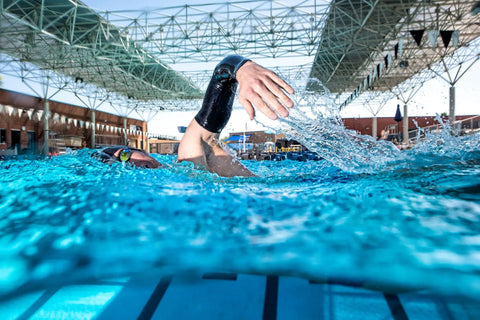How to Swim with a Snorkel
This post is courtesy of Abbie Fish of Swim Like A. Fish. From qualifying for the Olympic Trials to working at USA Swimming’s headquarters, Abbie has been on all sides of swimming. Abbie is a stroke mechanics guru and believes anyone with the heart to train can benefit from technical advice!
First off, most swimmers when they first start using a snorkel—HATE IT! I mean I don’t fault you or them—no one wants to get water in their mouth when they are trying to swim. It’s not fun. But with this, snorkel’s are a great training tool because they teach swimmers a few KEY things:
1.) How to have GREAT Body Alignment!

Snorkels are a great way for swimmers to learn proper head positioning—which leads straight into good body alignment.
If for some reason the snorkel is too low in the water, swimmers will get water into it. If for some reason the snorkel is too high—the same thing can happen. So finding proper body alignment is necessary when using a snorkel, otherwise, you’ll just be choking as you go down the pool.
2.) They INCREASE your aerobic capacity!

Because snorkels have a smaller orifice than your mouth, you get less air per breath. You can even make that hole smaller (which my coaches did to me when I was swimming with duct tape or a plastic piece) to further minimize the amount of air swimmers get.
On top of that, swimmers have to make that air travel further to get into their body—than if they were not using a snorkel. The tube of the snorkel makes a swimmer breathe DEEPER than they would during both the inhale and exhale, which increases swimmer’s overall aerobic capacity—which is why coaches use them!
3.) They take the BREATH out of it!

Snorkels are great because they allow swimmers to swim without worrying about turning their head to one side to breathe. This, in turn, allows a swimmer to focus more on their technique (pulling pattern, kick, rotation, body alignment, etc.) because the eyeballs stay down.
If swimmers keep their head down while swimming freestyle, they can actually watch their hands go through their pulling pattern BETTER than taking a breath every couple strokes.
This focus makes it easier for any swimmer to get the visual feedback they need on their body, including any auditory feedback from their coach.
So how EXACTLY do you swim with one?
Well, there are really a few necessary components. First off, you want to make sure you are relaxed. One thing I always tell my swimmers is that just because you have a snorkel on—doesn’t mean we are restricting your breathing. If anything, we are actually letting you breathe more than you would without one because you can breathe at any time.
There is definitely a level of fear that goes into using a snorkel and it being outside of a swimmer’s norm that each swimmer must overcome to feel fully relaxed while using a snorkel.
Secondly, swimmers must bite DOWN on the mouthpiece. When we are swimming regularly, we don’t normally keep our jaw clinched. With a snorkel, you have to use the muscles of your mouth to actively bite down on the mouthpiece to keep the snorkel from moving around AND avoid watering coming in through the bottom.
Thirdly, you have to find proper body alignment. This will be much easier if you have your coach look at your position with a snorkel on while swimming and from there, he/she can correct you. But a good rule of thumb is only about 4 inches of the snorkel’s tube should be showing above the surface of the water. This means, your head needs to be down!
Fourthly, whenever the snorkel goes UNDER the water (i.e. from a push-off or flip turn)–you must think of yourself as a whale with a blowhole and BEFORE you breathe in, you MUST exhale out! That is the only way to guarantee you don’t gag on any water!
With this, the exhale out cannot be small—it needs to be forceful and as aggressive as possible. You don’t want any water left in that snorkel, so if you just exhale very passively or not entirely—you will be choking on water before you even break out.
Be sure to stay tuned for future posts, where we discuss how to FLIP TURN with a snorkel.
Until Next Time,
Abbie Fish
Learn more from A3 Performance Partner Abbie Fish on Social Media:
